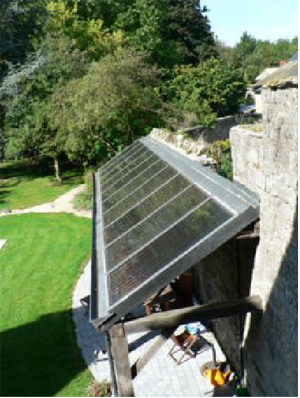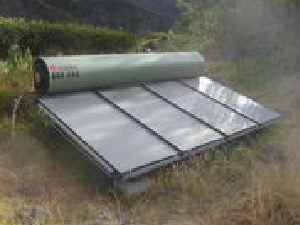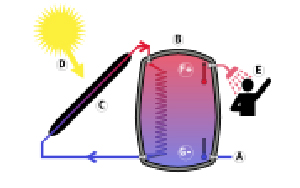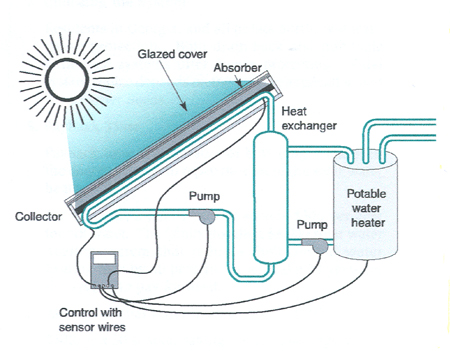 Solar
hot water heaters can provide households with a large portion of their
hot water needs while cutting back on home energy costs. The amount of hot water
that solar energy will provide depends on the type and size of the system, the
climate, and the quality of the site in terms of solar access. A back-up heating
system for water will be necessary during times when solar radiation is insufficient
to meet hot water demands. Solar water heating is a simple, efficient, and affordable
technology that provides hot water and saves on energy bills.
Solar
hot water heaters can provide households with a large portion of their
hot water needs while cutting back on home energy costs. The amount of hot water
that solar energy will provide depends on the type and size of the system, the
climate, and the quality of the site in terms of solar access. A back-up heating
system for water will be necessary during times when solar radiation is insufficient
to meet hot water demands. Solar water heating is a simple, efficient, and affordable
technology that provides hot water and saves on energy bills.
Solar water heaters lower the cost of electric bills. A typical consumer can save
about 30%-50% on his or her electric bill, while lessening the use of oil and
the impact on the environment.
Water (or non-toxic antifreeze solution) travels through dark colored pipes that
are located in direct sunlight. The sun heats the water in the pipes. Once heated,
the water is stored in an insulated tank until needed. In instances where there
is no sun for a prolonged period of time, an auxiliary back up water heating system
is used. Often the back up water heater is the storage tank itself and therefore
does not cost extra. A southern orientation is optimal, but not required.
The systems may be used to heat water for a wide variety of uses, including home,
business, and industrial uses. Heating swimming pools, under-floor heating, or
energy input for space heating are more specific examples.
Residents can typically cut their water heating needs by 40-80 percent and save
between $120 and $240 annually.
In many climates, a solar heating system can provide up to 85% of domestic hot
water energy. In many northern European countries, combined hot water and space
heating systems (solar combisystems) are used to provide 15 to 25% of home heating
energy.
Why Solar Water Heating? Besides saving money, solar water heating increases the
amount of hot water available, requires little maintenance, and reduces the amount
of pollution created by burning fossil fuels.
The first step in considering solar water heating is to adopt water and energy
efficiency measures. For example, low-flow shower heads, aerators, and frontloading
washing machines can drastically reduce the amount of hot water used.
Types and Systems:
Passive: A system not driven by mechanical means, but by thermo-siphoning
only. Hot water rises - cold water falls, thus creating a circular motion.
Active: A system driven by mechanical means, usually a pump.
Direct: A system where the water and heated medium is the same.
Indirect: A system where the heated medium and water are separated by a
heat- exchanger.
 Passive Direct
System: A passive system also known as a monobloc (thermosiphon)
system, a compact system consists of a tank for the heated water, a solar collector,
and connecting pipes all pre-mounted in one frame. The water flows upward (thermo-siphon)
when heated in the panel. When this water enters the tank (positioned higher than
the solar panel), it expels some cold water from inside so that the heat transfer
takes place without the need for a pump. A typical system for a four-person home
in a sunny region consists of a tank of 150 to 300 liters (36.9 to 79.2 gallons)
and three to four square meters of solar collector panels.
Passive Direct
System: A passive system also known as a monobloc (thermosiphon)
system, a compact system consists of a tank for the heated water, a solar collector,
and connecting pipes all pre-mounted in one frame. The water flows upward (thermo-siphon)
when heated in the panel. When this water enters the tank (positioned higher than
the solar panel), it expels some cold water from inside so that the heat transfer
takes place without the need for a pump. A typical system for a four-person home
in a sunny region consists of a tank of 150 to 300 liters (36.9 to 79.2 gallons)
and three to four square meters of solar collector panels.
 Active
System: Conventional Active systems use a powered circulation pump whenever
the hot water tank is positioned below the solar panels. Most systems in northern
Europe are of this type. The storage tank is placed inside the building, and thus
requires a controller that measures when the water is hotter in the panels than
in the tank. The system also requires a pump for transferring the fluid between
the parts.
Active
System: Conventional Active systems use a powered circulation pump whenever
the hot water tank is positioned below the solar panels. Most systems in northern
Europe are of this type. The storage tank is placed inside the building, and thus
requires a controller that measures when the water is hotter in the panels than
in the tank. The system also requires a pump for transferring the fluid between
the parts.
 Indirect
System: A non-toxic antifreeze solution is heated in the solar panel and
is pumped through a heat exchanger. The heat exchanger exchanges the heat from
the medium to the water - water that that feeds into the hot-water tank.
Indirect
System: A non-toxic antifreeze solution is heated in the solar panel and
is pumped through a heat exchanger. The heat exchanger exchanges the heat from
the medium to the water - water that that feeds into the hot-water tank.
The medium in the collector can reach very high temperatures in good sunshine,
or if the pump fails. Designs should allow for relief of pressure and excess heat
through a heat dump.
A well-made, properly-maintained system should last 15 to 20 years or more, which
means your decision to invest will have long-lasting results.
A solar system places all the costs upfront. From there the sun serves as a renewable
fuel source that costs the homeowner virtually nothing to use. A family of four
needs two 4' x 10' collector panels connected to a 40-80 gallon storage tank.
Types of thermal collectors:
 Evacuated
tube collector
Evacuated
tube collector
Evacuated tube collectors are made of tubes, mounted in parallel, whose number
can be added to or reduced as hot water delivery needs change, each of which contains
an absorber tube. The tubes are covered with a special light-modulating coating.
In an evacuated tube collector, sunlight passing through an outer glass tube heats
the absorber tube contained within it. The absorber can either consist of copper
(glass-metal) or specially-coated glass tubing (glass-glass).
Formed plastic collector
Formed plastic collectors (such as polypropylene, EPDM or PET plastics) consist
of tubes or formed panels through which water is circulated and heated by the
sun's radiation. These are often used for extending the swimming season in swimming
pools. In some countries, heating an open-air swimming pool with non-renewable
energy sources is not allowed, and then these inexpensive systems offer a good
solution. This panel is not suitable for year-round uses like providing hot water
for home use, primarily due to its lack of insulation which reduces its effectiveness
greatly when the ambient air temperature is lower than the temperature of the
fluid being heated.
Flat plate collector
A flat plate collector consists of a thin absorber sheet backed by a grid or coil
of fluid tubing and placed in an insulated casing with a glass or polycarbonate
cover.
Fluid is circulated, using either mains or solar electricity, through the tubing
to remove the heat from the absorber and to transport it to an insulated water
tank, sometimes directly or via a heat exchanger.
As an alternative to metal collectors, new polymer flat plate collectors are now
being produced in Europe. These may be wholly polymer, or they may be metal plates
behind which are freeze-tolerant water channels made of silicone rubber instead
of metal. Polymers, being flexible and therefore freeze-tolerant, are able to
contain plain water instead of antifreeze, so that in some cases they are able
to plumb directly into existing water tanks instead of needing the tank to be
replaced with one using heat exchangers. By dispensing with a heat exchanger,
these flat plate panel temperatures need not be quite so high for the circulation
system be switched on, so such direct circulation panels, whether polymer or otherwise,
can be somewhat more efficient, particularly at low light levels.
As with evacuated tubes, most flat plate collectors have a life expectancy of
over 25 years.
 Solar
hot water heaters can provide households with a large portion of their
hot water needs while cutting back on home energy costs. The amount of hot water
that solar energy will provide depends on the type and size of the system, the
climate, and the quality of the site in terms of solar access. A back-up heating
system for water will be necessary during times when solar radiation is insufficient
to meet hot water demands. Solar water heating is a simple, efficient, and affordable
technology that provides hot water and saves on energy bills.
Solar
hot water heaters can provide households with a large portion of their
hot water needs while cutting back on home energy costs. The amount of hot water
that solar energy will provide depends on the type and size of the system, the
climate, and the quality of the site in terms of solar access. A back-up heating
system for water will be necessary during times when solar radiation is insufficient
to meet hot water demands. Solar water heating is a simple, efficient, and affordable
technology that provides hot water and saves on energy bills.  Passive Direct
System: A passive system also known as a monobloc (thermosiphon)
system, a compact system consists of a tank for the heated water, a solar collector,
and connecting pipes all pre-mounted in one frame. The water flows upward (thermo-siphon)
when heated in the panel. When this water enters the tank (positioned higher than
the solar panel), it expels some cold water from inside so that the heat transfer
takes place without the need for a pump. A typical system for a four-person home
in a sunny region consists of a tank of 150 to 300 liters (36.9 to 79.2 gallons)
and three to four square meters of solar collector panels.
Passive Direct
System: A passive system also known as a monobloc (thermosiphon)
system, a compact system consists of a tank for the heated water, a solar collector,
and connecting pipes all pre-mounted in one frame. The water flows upward (thermo-siphon)
when heated in the panel. When this water enters the tank (positioned higher than
the solar panel), it expels some cold water from inside so that the heat transfer
takes place without the need for a pump. A typical system for a four-person home
in a sunny region consists of a tank of 150 to 300 liters (36.9 to 79.2 gallons)
and three to four square meters of solar collector panels.  Active
System: Conventional Active systems use a powered circulation pump whenever
the hot water tank is positioned below the solar panels. Most systems in northern
Europe are of this type. The storage tank is placed inside the building, and thus
requires a controller that measures when the water is hotter in the panels than
in the tank. The system also requires a pump for transferring the fluid between
the parts.
Active
System: Conventional Active systems use a powered circulation pump whenever
the hot water tank is positioned below the solar panels. Most systems in northern
Europe are of this type. The storage tank is placed inside the building, and thus
requires a controller that measures when the water is hotter in the panels than
in the tank. The system also requires a pump for transferring the fluid between
the parts. Indirect
System: A non-toxic antifreeze solution is heated in the solar panel and
is pumped through a heat exchanger. The heat exchanger exchanges the heat from
the medium to the water - water that that feeds into the hot-water tank.
Indirect
System: A non-toxic antifreeze solution is heated in the solar panel and
is pumped through a heat exchanger. The heat exchanger exchanges the heat from
the medium to the water - water that that feeds into the hot-water tank. Evacuated
tube collector
Evacuated
tube collector